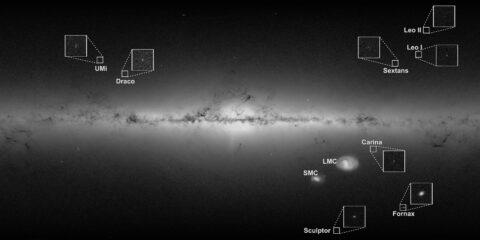With my collaborators around Francois Hammer (GEPI, Paris Observatory) we have published a new series of papers on the dwarf galaxies surrounding the Milky Way:
- “The accretion history of the Milky Way – I. How it shapes globular clusters and dwarf galaxies“, Hammer, F., Li, H., Mamon, G. A., Pawlowski, M. S., Bonifacio, P., Jiao, Y., Wang, H., Wang, J., Yang, Y. (2023), MNRAS, 519, 5059.
- “The accretion history of the Milky Way. II. Internal kinematics of globular clusters and of dwarf galaxies“, Hammer, F., Wang, J., Mamon, G. A., Pawlowski, M. S., Yang, Y., Jiao, Y., Li, H., Bonifacio, P., Caffau, E., Wang, H. (2023), MNRAS, 527, 2718.
- “The Accretion History of the Milky Way: III. Hydrodynamical Simulations of Galactic Dwarf Galaxies at First Infall“, Wang, J., Hammer, F., Yang, Y., Pawlowski, M. S., Mamon, G. A., Wang, H. (2023), arXiv: 2311.05687
 The results indicate that many of them might have been accreted only recently, which in turn does not give them much time to be transformed from the gas-rich, rotating dwarfs found at larger distances from the Milky Way, to the gas-free pressure-supported dwarf spheroidals in the vicinity of our Galaxy. We propose that gas-dominated, dark matter free dwarfs might fit the bill, as they are both transformed quickly and also undergo “ram-pressure breaking” which slows them down. Upon being stripped of their gas by the hot halo of the Milky Way, their stellar distribution expands (see this video). Interestingly, this can explain why for many observed dwarfs stars are now found at very large distances. Ultimately, the dwarfs end up out of equilibrium, which means that common estimates of their dark matter content that must assume equilibrium might be unreliable.
The results indicate that many of them might have been accreted only recently, which in turn does not give them much time to be transformed from the gas-rich, rotating dwarfs found at larger distances from the Milky Way, to the gas-free pressure-supported dwarf spheroidals in the vicinity of our Galaxy. We propose that gas-dominated, dark matter free dwarfs might fit the bill, as they are both transformed quickly and also undergo “ram-pressure breaking” which slows them down. Upon being stripped of their gas by the hot halo of the Milky Way, their stellar distribution expands (see this video). Interestingly, this can explain why for many observed dwarfs stars are now found at very large distances. Ultimately, the dwarfs end up out of equilibrium, which means that common estimates of their dark matter content that must assume equilibrium might be unreliable.
If you want to know a bit more without reading the papers in full: press releases on the topic were just published by both the Leibniz Institute for Astrophysics and the Paris Observatory.
